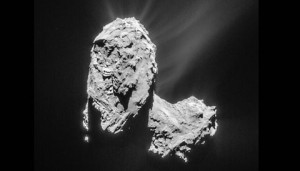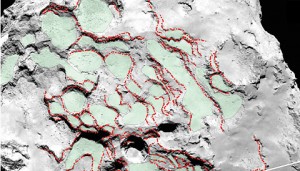Comet 67P’s nucleus was born when two became one.

ESA / Rosetta / NAVCAM
Comet nuclei often look weird. They can be oblong or misshapen potatoes, marred with craters and sinkholes. But when ESA’s Rosetta spacecraft first sent back images of the nucleus of Comet 67P/Churyumov-Gerasimenko, team scientists were a bit baffled by the “rubber ducky” they saw. The dirty iceball has two, kilometer-scale lobes, one about twice as wide as the other, connected by a thick “neck.”
Since these first images came in, astronomers have debated why Comet 67P looks this way. They have two ideas: either the current nucleus is the product of two separate ones that gently collided in the outer solar system and stuck together, or so much material eroded away from the neck region that it narrowed into a column.
The Rosetta team now says they have the answer, and it’s that the comet was born when two nuclei became one.
Matteo Massironi (University of Padova, Italy) and colleagues used images from the narrow-angle and wide-angle cameras of Rosetta’s Optical, Spectroscopic, and Infrared Remote Imaging System (OSIRIS) to investigate the nucleus’s origin. Some of these images reveal features down to 0.1 meter (0.3 foot) across, showing a nucleus akin to frozen putty, covered with terraces, pits, and cliffs.

ESA / Rosetta / MPS for OSIRIS Team MPS / UPD / LAM / IAA / SSO / INTA / UPM / DASP / IDA; M. Massironi et al. 2015
It’s these features that the team took advantage of. With OSIRIS, the scientists peered down into pits and along terraces and found strata, layers of material like those you would see in rock on Earth, built up as the rock formed one layer at a time. Many of Comet 67P’s layers extend 150 meters or deeper, in some places reaching 650 meters down. You can think of them like the layers in an onion, the team explains September 28th in Nature.
The layers are too flat to be material rained down on the irregular surface after its formation, so like terrestrial strata, they were probably deposited during the nucleus’s formation.
If so, then these onion layers should form concentric rings around their parent body’s center of mass. If the nucleus began as one object, then the strata will encircle one center; if it began as two, then the strata in the duck's head and body will be oriented around different centers of mass, each in their respective lobes.
The team traced out the strata’s surfaces and extrapolated where the onion center was. They found that the layers do encircle two different centers, one in each lobe. Thus, Comet 67P’s nucleus formed in a low-speed collision of two nuclei. But the result also shows that the two objects — which we could now call Churyumov and Gerasimenko — formed in a similar way, accreting layers over time. Layering observed in other comet nuclei during flybys hints that Churyumov and Gerasimenko aren’t the only ones to have formed this way, study coauthor Björn Davidsson (Uppsala University, Sweden) says in the ESA press release.
Reference: M Massironi et al. “Two independent and primitive envelopes of the bilobate nucleus of comet 67P.” Nature. Published online September 28, 2015.
Subscribe to Sky & Telescope for more news on the science and hobby of astronomy.
 4
4









Comments
jaime
October 6, 2015 at 11:49 am
Please explain , how csn two small comets or any other small asteroides, can stick together ??? Do they have their owns gravity.??..and if this happens, how do it happens ???.rrocks in earth, dont stick together that way (for some reason? ). Thanks
You must be logged in to post a comment.
Anthony Barreiro
October 6, 2015 at 1:24 pm
Hi Jaime. I'll take a stab at your question.
Firstly, every object exerts a gravitational attraction on every other object. The force of gravity between two objects is proportional to the combined masses of the two objects and the inverse square of the distance between them. So the more mass something has, the more strongly it will attract other things, and the closer two things are to one another the more strongly they will be attracted to one another. Two rocks on the surface of the Earth will each be much more strongly attracted to the Earth than to one another. Imagine two rocks out in space, in similar orbits around the Sun, so they're moving at about the same speed and in the same direction. These rocks are far from the Sun and any planet but close to one another -- voila, the force of their gravitational attraction to one another is strong enough to pull them together. (This is Newtonian physics, which I somewhat understand. Einstein's general theory of relativity holds that gravity is a curvature in the fabric of space-time, and that more massive objects curve space-time more strongly. You don't need to understand general relativity to answer your question, which is a good thing for me.)
Secondly, a typical rock on Earth is very dense and hard. A typical comet is much fluffier and softer. Rather than trying to get two rocks to stick together, imagine squishing two snowballs together to make a bigger snowball.
And, extending beyond your immediate question, planetary scientists need to understand how little things stuck together to form bigger things in the early solar system in order to understand how the planets formed from a huge diffuse cloud of gas and dust. This is one very important reason they study comets and asteroids, because these small old objects help us understand what happened when the solar system was forming.
You must be logged in to post a comment.
Joey Egleston
October 7, 2015 at 9:12 am
Was it two comets somehow orbiting each other, or something else? I have zero clues to how that would work.
You must be logged in to post a comment.
Ian-Frazer
October 12, 2015 at 12:44 am
Joeybafoey.
Same logic. Little grains get attracted to larger grains, slightly larger or much larger doesn't matter. As long as their orbits & accel are about the same, they'll hang around each other.
Add in electrostatic and/or chemical attraction, add a little frozen slush "stuff" for stickyness, and over a looong period of time, you get bigger and bigger things attracting smaller things. The faster one item grows, the more it attracts - eventually getting large enough to clear it's orbit & become what we know as a planet. Or a comet.
You must be logged in to post a comment.
You must be logged in to post a comment.